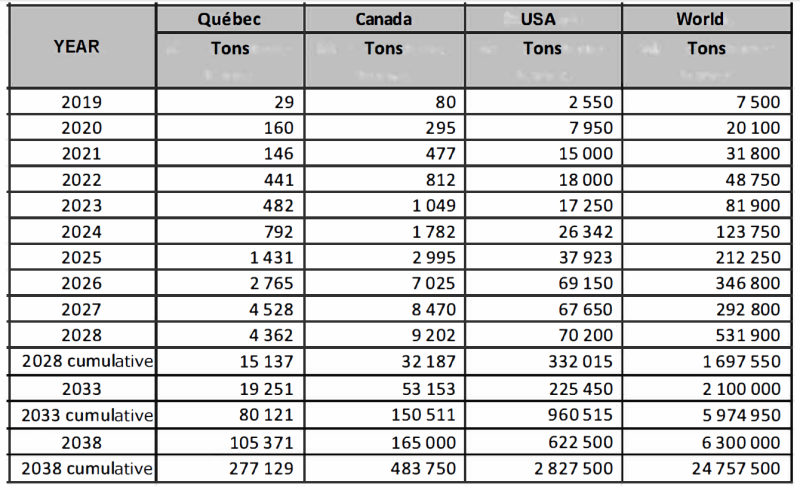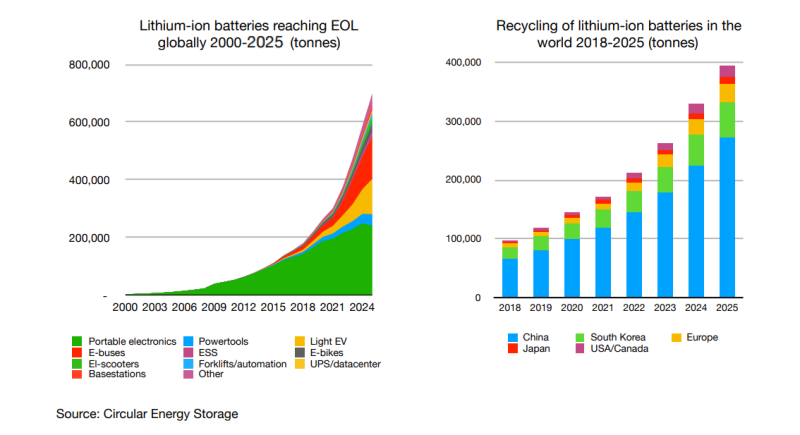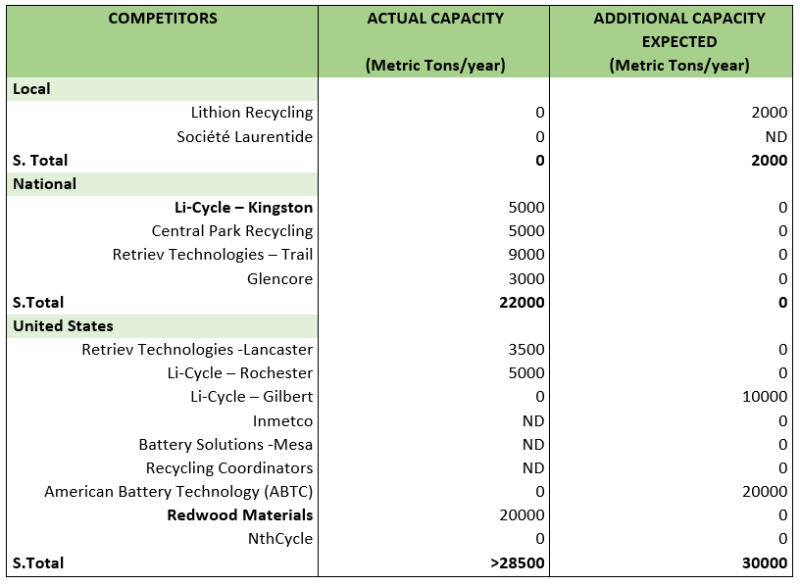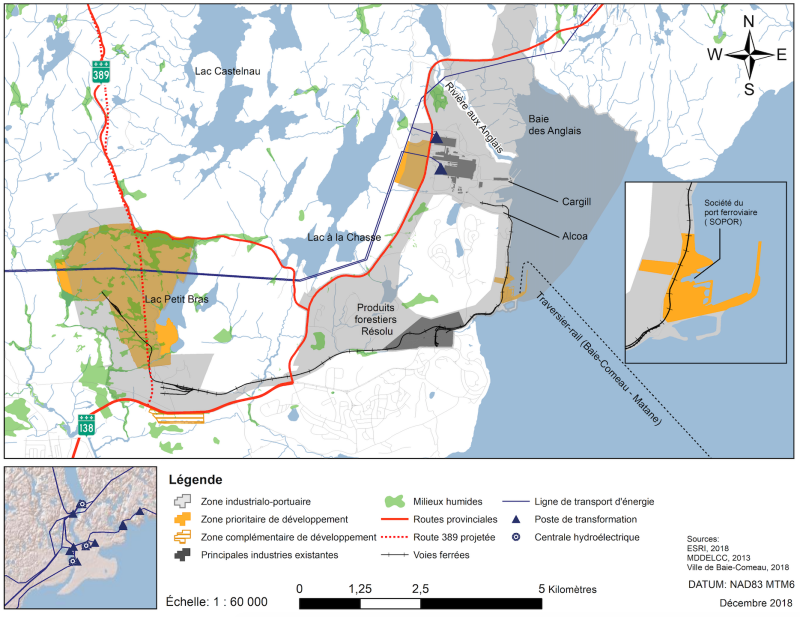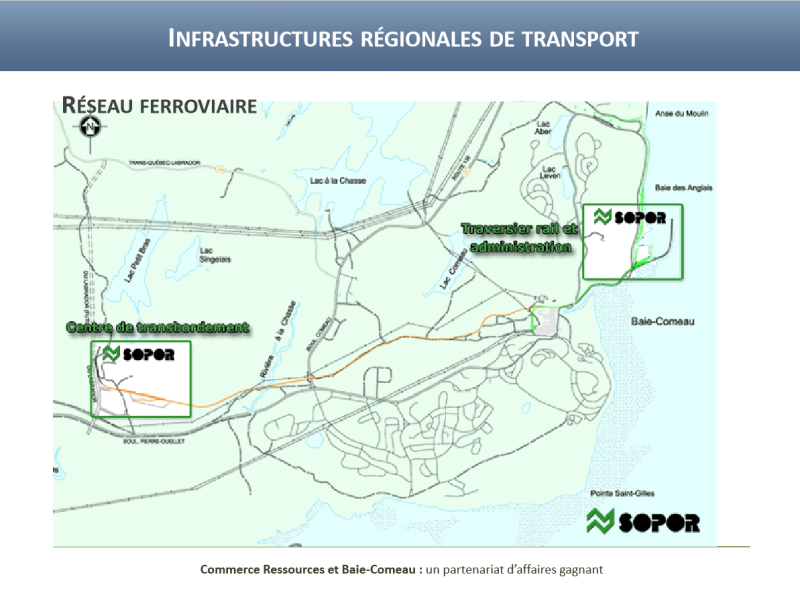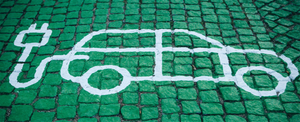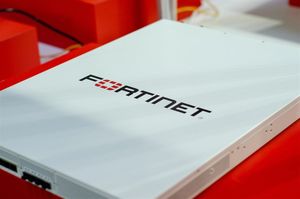


Montréal - TheNewswire - June 24, 2021 - St-Georges Eco-Mining Corp. (CNSX:SX.CN) (OTC:SXOOF) (FSE:85G1) is pleased to disclose that last week it received a preliminary report from Globerpro, the group tasked with coordinating its ongoing feasibility study for the EVSX proposed battery recycling operation in the city of Baie-Comeau on the Québec North-Shore.
This press release outlines and summarizes some of the key findings of the study. Some elements have been kept confidential to protect intellectual property and industrial secrets.
The preliminary report covers many topics in detail, allowing the Company to accelerate permitting and grant requests as well as alternative financing. The in-depth research involved data obtained from governments, industry operators, and car manufacturers.
Recent Model Development Evolving in Parallel with the Feasibility Study
The findings helped the Company negotiate with industrial equipment vendors and allowed management to direct its engineering design and equipment acquisition. The preliminary report also convinced management to design the plant as a scalable operation with the aim to deliver the lowest possible CAPEX costs. The building and land identified should allow the Company to save months, if not years, of sourcing material, eliminating construction timelines, and drastically reducing building reconfiguration and adaptation.
The Company’s currently adopted model that will be used for the final feasibility study in support of the operation’s debt financing is based on four parallel processing circuits. This model allows a first phase of 10,000 tons of batteries per year from the first day of operation up to 90,000 tons of batteries to be recycled per year using the initial four circuits. Additional capacity to be added in the future could allow for 70,000 tons of feedstock to be processed in the tech plant, representing approximately 225,000 tons of batteries per year to be recycled at the plant.
-
- 10,000 tons of batteries entering the industrial process represent approximately 3,000 of mineral feedstock or battery cells to be treated in the chemical plant portion of the operation.
- The Company expects to be able to process up to 20,000 tons of feedstock per year within the current building. It aims to process up to 70,000 tons of feedstock per year within the confines of the plant footprint and land with future expansion.
The Company is negotiating the acquisition of all the industrial equipment required for the first circuit. It expects reception of these units during the third quarter of this year. The equipment to be delivered is expected to allow the processing of up to 79,200 tons of gross batteries or approximately 20,000 tons of feedstock available for the chemical tech plant portion of the EVSX operations in Baie-Comeau. By way of comparison, Li-Cycle’s declared capacity in Ontario, Canada, is currently 5,000 tons per year with additional capacities of 15,000 tons presently being planned and built in the United States and a planned plant with a 20,000 tons per year capacity with Redwood Materials also in the United States.
Key Elements of the Preliminary Report
Costs, Capex, Opex, Revenue Projections
Construction costs, equipment acquisitions, and financing are being kept confidential for now. However, the Company’s management is comfortable to disclose that no large equity financing is being planned to finance the operations and that cash on hands, grants, and debts, as well as equipment vendor lease-to-buy programs, should finance the totality of the proposed operations. The Company will release cash flow projections with excerpts from the final feasibility report expected later this summer.
Key Challenges Identified
Access to Used Batteries and Feedstock Material to be Processed
The main challenge identified by the preliminary report lies in accessing EV batteries to be recycled. The current availability is severely limited. Projections based on different data sources and systematically directed interviews with car manufacturers show that the Electric Vehicle battery recycling market is currently microscopic in size and won’t take flight for another decade.
Table 4 of Report - Projection of electric vehicle batteries available for recycling (Plante, 2021-05-31)
Figure 6 of Report - Quantity of recycled lithium batteries (in tons) (Flash Battery, 2021)
The Company’s phase 1 project design incorporates four processing circuits: three full-length circuits from dismantling to purification and one circuit that only targets feedstock and concentrates. Over time this will allow for easier shut down for maintenance or simply for reconfiguration for other types of batteries.
The current study confirms that the Company will be able to counter the limited availability of EV batteries to be recycled in the first few years of operations by supplementing the availability of EV batteries with domestic rechargeable batteries, commercial (power tool) batteries, and feedstocks (internal combustion vehicle batteries (ICE)’s black mass, mineral concentrate, etc.).
Competition
The lack of sizeable availability of EV batteries will be exacerbated by a surge of recycling capacity coming online in the short term. It was noted that EVSX would need to establish partnerships with governments and industry aggregators if it wants to have access to a steady minimum supply. The preliminary report covers in detail the partnerships and relationships currently being established. This portion of the report will be kept confidential for the time being.
Table 7 - Summary of competitors in Canada and the United States (Plante, 2021-05-31)
Environmental Challenges
A preliminary environmental evaluation is detailed in this report. The initial conclusions of the consultants point to the requirement of an environmental ministerial authorization and exclude the project from the environmental impact evaluation and examination process (REEIE). This allows the Company to stay within its projected timeline. In addition, the segregation of the tech plant circuit allows for scalability and ease of maintenance and limits the size of the acid tanks to less than 10,000 m³ allowing for simpler environmental permitting process. The consultants otherwise note that phase 2 of the project would bring it within the constraints of the full environmental review process.
Process Review
A good portion of the report covers the Company’s industrial and chemical processes. Some challenges are mentioned, like the conversion of some of the process outputs and the disposition of the plastics and other PVCs. Both aspects are being covered in a partnership with third parties who will remain confidential at this point.
Some important aspects of the process, specific to the recycling of batteries, should otherwise be disclosed in this release. One important aspect of recycling domestic and commercial batteries is the usually problematic residual electric charge.
One challenge mentioned by the report has a solution that is not being covered by the preliminary report: The Company has designed a solution to discharge the batteries’ residual electric charge in bulk and is working on the recuperation of this electricity to be sold to the private electric grid of the local municipality in the context of the current project. This aspect of the process will generate new patent filings and, therefore, will not be disclosed at this time.
Although the validation of the chemical technical process itself is handled by WSP in a “black box” and will not be disclosed until the final feasibility report, the current report covers all aspects surrounding it.
Material Entering the Industrial Plant
The following table shows the estimated annual tonnage of materials coming into the EVSX battery recycling plant.
|
Material |
Projected Annual Tonnage |
|
Batteries Entering the process – UP1 (packs) |
20 000 - 30 000 |
|
Batteries Cells entering the Tech Plant - UP5 |
10 000 |
|
Aluminum |
2 000 |
|
Copper |
2 500 |
|
Carbon |
2 500 |
|
PVDF |
250 |
|
Electrolytes |
1500 |
|
Plastics |
350 |
|
Active Cathode Material |
4 500 |
|
Iron |
250 |
|
Cooling Liquids |
To be determined |
|
Electronics |
To be determined |
Minimum Scenario used for Active Cathode Material Recuperation
Cathode active materials impact a battery’s capacity and voltage. Recycling these materials may prevent future shortages. This table represents the minimum scenario used for Active Cathode Material (ACM) recuperation.
|
Element |
Min t/an |
Max t/an |
|
Li |
55 |
112 |
|
Co |
- |
287 |
|
Ni |
- |
694 |
|
Mn |
- |
863 |
|
Fe |
- |
503 |
|
Al |
- |
20 |
List of Material Expected to be Recycled in this Process
Traditional battery recycling focuses on removing expensive metals, leaving the balance of the materials to be sold, exported, or incinerated in a waste-to-energy program. This is further complicated by the fact that each battery has its own structure and composition, and manufacturers are not required to disclose battery contents. The EVSX battery recycling plant will recover typical battery materials as well as metal processing by-products.
|
Sub-System |
Recuperated Material |
|
Cells |
Active Cathode Material Lithium Cobalt Nickel Manganese Fer Aluminum Black Mass Graphite Particle (PVDF)-Copper Aluminum |
|
LiPF6 – Electrolyte Ethylene carbonate- Electrolyte Dimethyl carbonate- Electrolyte |
|
|
Polypropylene – Plastic Polyethylene - Plastic Polyethylene terephthalate – Plastic |
|
|
Modules (casings) |
Copper Aluminum Polyethylene Electronic |
|
Packs (global casing) |
Copper Aluminum Steel Isolation Cooling Liquid Electronic |
Regional Logistics
Figure 16 of Report- Baie-Comeau industrial port zone (Ville Baie Comeau, 2018)
Figure 17 of Report - Map of the rail network around Baie-Comeau (ID Manicouagan, 2020-05a)
Local Economic Impact Benefits
The report outlines the advantages of choosing the Baie-Comeau area for the project’s first industrial plant beyond the infrastructure and geographical location. In addition, the proximity of the Alcoa aluminum plant is of additional positive merit identified. The research highlights that the level of support the project is receiving from the City of Baie-Comeau and local governments, for what is overall a small $30 million phase 1 project, would not necessarily be received similarly in other markets. Baie-Comeau is orienting its future development around battery metals, green energy, and the transport industry. The region sees the EVSX project as a steppingstone capable of attracting complementary projects over time.
Conclusion of the Report, Excerpt translated from French
The battery recycling plant project presented by EVSX finds its strength in its:
-
- Original approach to the different stages of separation, distinct from the competition, and ongoing R&D
- Process flexibility to handle batteries with variable compositions
- Potential for upgrading acid residues
- Expertise in processing minerals in solution
Through its location, the project also leverages other assets:
-
- Strong logistics infrastructure (boats, trucks, trains) in the region
- Possibility of receiving materials from Europe and the USA
- Ongoing discussions with players who supply batteries to be recycled
- Ongoing discussions with potential customers of the materials that will be produced
EVSX's business plan for the coming months is to confirm these strengths, for example, by securing various letters of intent, and to refine the elements of the project under review as of the publication date of this report. Among these elements, we may quote:
-
- The detailed definition of the recycling process and its costing
- Establishing R&D partnerships to carry out this project
- The protection of the intellectual property created
- Establishing partnerships with battery collectors
- Consolidation of the economic and financial model of the pilot plant
- Finding financial resources to invest in the pilot installation
The first phase of this feasibility study highlighted the challenges to be tackled in the coming weeks, as well as the opportunities for competitive differentiation. It did not identify any barriers that would prevent the continuation of the pilot-plant project business opportunity analysis.
About Globerpro
Founded in 1998 in Montreal, Globerpro International supports businesses in their transformation and development projects. Globerpro’s mission is to support companies by addressing the strategic issues and challenges they face and to help them stand out through innovation and the quality of their management. Over the years, the team has earned an enviable reputation for its approach, its knowledge of the markets, the validity of its actionable recommendations, and its ability to carry projects to concrete outcomes that benefit clients.
ON BEHALF OF THE BOARD OF DIRECTORS
“ Frank Dumas”
FRANCOIS (FRANK) DUMAS
Director & COO
About St-Georges
St-Georges is developing new technologies to solve some of the most common environmental problems in the mining industry. The Company controls all the active mineral tenures in Iceland. It also explores for nickel & PGEs on the Julie Nickel Project and the Manicougan Palladium Project on the Québec’s North Shore. Headquartered in Montreal, St-Georges’ stock is listed on the CSE under the symbol SX, on the US OTC under the Symbol SXOOF and on the Frankfurt Stock Exchange under the symbol 85G1.
The Canadian Securities Exchange (CSE) has not reviewed and does not accept responsibility for the adequacy or the accuracy of the contents of this release.
Copyright (c) 2021 TheNewswire - All rights reserved.
